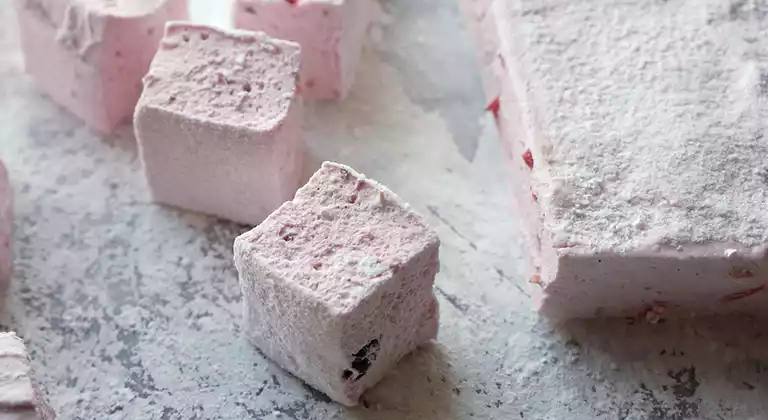History of Marshmallows: From medicine to Sweet Snack

Marshmallow is a light, fluffy, melt-in-your-mouth candy that is loved by everyone. Its English name comes from a plant called mallow which found in the marshes of Europe, North Africa, and Asia. The fleshy stems, leaves, and roots are rich in viscous vegetable gum.
Marshmallows can be dated back to ancient Egypt in 2000 BC. Egyptians obtained a jelly when the boiled mallow cooled. Then, they mixed it with milk and honey to make an ointment to soothe cough and sore throat. It resembled gummy candy rather than modern marshmallow because air or bubbles didn’t exist in it. This ancient marshmallow was produced on a small scale due to the rare raw materials, so it was only a medicine and dessert for the royal family, or an offering to the gods.
Modern marshmallow was invented by the French in the mid-19th century. The sap from mallow root, sugar, egg whites, and water are whipped until they are fluffy and spongy. However, the cumbersome production process, drying and preparation took several days. Marshmallow was only made by individual confectionery store owners and sold in strip or lozenge.
By the end of 19 century, French confectioners had discarded mallow sap and switched to the more readily available gelatin. Marshmallow was usually dyed light pink by rose extract. At the same time, the invention of starch mold revolutionized its production. Starch was evenly filled into a metal tray, and then the customed shapes were pressed into starch powder to left rows of cavities. The foam with gelatin and 25% water was injected into cavities where its water was decreased to about 15% by starch absorption. The production time was shortened to one day, and candies of various shapes could be mass-produced. Inexpensive marshmallows were packed in cans and sold to the public on the streets of Europe and America in the early 20th century.
The 25% water may seem like a lot, but it is necessary. Otherwise, the foam cannot be poured into the starch cavities easily due to its reduced fluidity. Most of the time is spent on dehydration in starch mold. In the 1950s, Alex Doumake invented an extrusion machinery to shorten the time from one day to about one hour. This process does not require starch because the foam in the mixer contains about 15% water. Strips of marshmallow were extruded from pipes and cut into pieces. Today, fully automated production enables people all over the world to enjoy this delicacy. In addition to the classic style, marshmallows are coated with chocolate, or filled with jam and cream, or molded into various shapes.
The Core of Marshmallows: Foaming Agents and Gelatin
The fluffy, light, and smooth texture of marshmallows comes from their distinctive sponge-like porous structure and bubbles. An ideal bubble system needs to meet dual requirements – there are enough bubbles to expand its volume several times, and it also have a stable interface to prevent bubbles from bursting or merging. The hydrophobic groups of gelatin and soy protein powder anchor the air, while the hydrophilic groups extend into the syrup, reducing the surface tension and facilitating bubble generation. At the same time, a stable barrier in bubble is appeared as the gelatin and soy protein with charges repel each other.
Gelatin not only acts as a foaming agent in marshmallow, but it also becomes a gel to fix the foam after cooling. When temperature drops below 35°C, the charged polar groups such as amino groups, hydroxyl groups, and carboxyl groups in gelatin will attract each other through hydrogen bonds to generate an elastic net where sugar and water molecules, and tiny air bubbles are locked in meshes. Therefore, water will rarely seep from the candy surface, and large sugar crystals will be inhibited gelatin network.
Gelatin is more elastic than polysaccharide hydrogels such as agar, starch and gum. Therefore, marshmallow recovers quickly even if it is violently deformed. At the same time, it will also melt in your mouth to release its flavor even without chew because gelatin melting point is lower than human body temperature. Usually, the best type A gelatin (Bloom value ≥ 250g) is used to make marshmallows, because the gelatin content is within 5%, which is much less than the 8% in gummy candies, and they need to solidify before the air bubbles disappear.